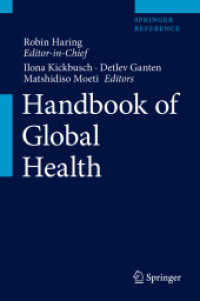- ホーム
- > 洋書
- > 英文書
- > Science / Mathematics
Full Description
A fundamental question in the theory of discrete and continuous-time population models concerns the conditions for the extinction or persistence of populations - a question that is addressed mathematically by persistence theory. For some time, it has been recognized that if the dynamics of a structured population are mathematically captured by continuous or discrete semiflows and if these semiflows have first-order approximations, the spectral radii of certain bounded linear positive operators (better known as basic reproduction numbers) act as thresholds between population extinction and persistence.
This book combines the theory of discrete-time dynamical systems with applications to population dynamics with an emphasis on spatial structure. The inclusion of two sexes that must mate to produce offspring leads to the study of operators that are (positively) homogeneous (of degree one) and order-preserving rather than linear and positive.
While this book offers an introduction to ordered normed vector spaces, some background in real and functional analysis (including some measure theory for a few chapters) will be helpful. The appendix and selected exercises provide a primer about basic concepts and about relevant topics one may not find in every analysis textbook.
Contents
Introduction
Cones and ordered vector spaces
The ordered vector space of real measures
Homogeneous operators
Spectral radii for homogeneous operators
Order-bounded operators
Upper semicontinuity of spectral radii
A left resolvent for homogeneous operators
Eigenvectors of (pseudo-)compact homogeneous operators
Continuity of the spectral radius
Eigenfunctionals
Turnover versus reproduction number
Linear maps on the vector space of measures
Nonlinear dynamics
Unstructured population models
A rank-structured population with mating
Two diffusing sexes and short reproductive season
Nonlocal spatial spread of semelparous two-sex populations
Populations with measure-valued structural distributions
Appendix A. Some tools from real analysis
Bibliography
Index








